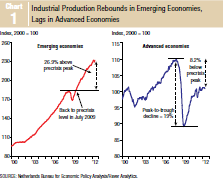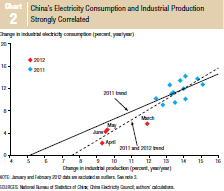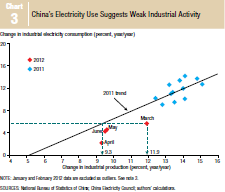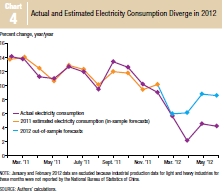![110516 - anti_spam[1]](https://www.macrobusiness.com.au/wp-content/uploads/2012/08/110516-anti_spam1.png)
From the Dallas Federal Reserve comes this today:
China’s Slowdown May Be Worse Than Official Data Suggest
by Janet Koech and Jian Wang
Vol. 7, No. 8, August 2012 | Issue in PDFIn the months following the 2008–09 economic crisis, emerging-market economies robustly rebounded. Output in China and India expanded more than 10 percent in 2010, and Brazil’s gross domestic product (GDP) growth of 7.5 percent was its best performance in 25 years. Emerging-market economies retraced their precrisis level of industrial production by 2009, while advanced economies remained below their precrisis levels in 2012 (Chart 1).
But the strong emerging-market rebound—most significantly in China—hasn’t endured. When China’s average GDP growth remained above 9 percent in 2011, hopes rose that a sustained recovery would prop up the world economy amid the European sovereign debt crisis and subpar growth in the U.S. However, China’s economy deteriorated rapidly in 2012, with GDP growth slowing to 8.1 percent in the first quarter from 8.9 percent at year-end 2011. Second quarter GDP growth slid further, to 7.6 percent, the lowest reading since the height of the global financial crisis in early 2009.
Even with the decline, there is speculation that these figures may still understate economic slowing. Economists have long doubted the credibility of Chinese output data. For example, some studies indicate that GDP growth was overstated during the 1998–99 Asian financial crisis, when official figures reported that China’s GDP grew on average 7.7 percent annually. Alternative estimates using economic activity measures such as energy production, air travel and trade data ranged from 2 percent to 5 percent.[1]
The dubious character of the official figures is no secret in China. Senior government officials, including Vice Premier Li Keqiang, dismiss official GDP data as “man-made” and “for reference only” because of political influence, particularly at the local level, on data reporting.[2]
Data Reliability
To get a more accurate picture of China’s economy, economists examine other measures of activity that closely track growth but are less prone to political interference than output data. Industrial electricity consumption, a major production input, serves as such a proxy. If industrial output grows at a slower pace, electricity consumption should behave similarly. China’s year-over-year growth rates of industrial electricity consumption and industrial production are shown for 2011 and 2012 in Chart 2.[3] Red dots, illustrating 2012 activity, are below the blue dots, depicting 2011, which indicates that the growth rate of industrial electricity consumption is relatively lower this year. This is consistent with China’s recent economic slowdown.
The chart also shows fitted linear trends—a way of extrapolating activity over a longer period—computed using 2011 data only (solid line) and 2011 and 2012 data (dashed line). This depiction relies on just these two years because of limited electricity-consumption reporting by the China Electricity Council. Hence, these results should be viewed with caution.
As expected, Chart 2 shows that there is a tight relationship between industrial electricity consumption and industrial output. As industrial production growth expands, China’s industries consume more electricity, and vice versa. However, a closer look at the chart raises questions.
Consider a scenario in which electricity consumption doesn’t increase. To illustrate this, we extend the linear trend lines to the horizontal axis (representing no change in electricity consumption). The lines intercept the axis at 5 and 7.5, implying that China’s industrial production continues to grow 5 percent or 7.5 percent annually (depending on which trend line we use) even when electricity consumption remains constant. Although heightened electricity consumption efficiency could induce positive industrial production growth, a 7.5 percent growth rate seems too large to attribute to efficiency gains alone.
The solid line computed using just 2011 data is flatter than the dashed line computed using both 2011 and 2012 data. Extrapolating from the trend line that includes just 2011 data points yields a lower, more reasonable industrial production growth rate of about 5 percent when the electricity consumption growth rate is zero.
The same data are shown in Chart 3, with only the 2011 trend line depicted. Suspiciously, all 2012 data (red dots) lie below the trend line. This suggests that given the amount of electricity consumed, China’s official industrial production figures for 2012 are higher than those implied by the 2011 data trend. For instance, China’s industrial electricity consumption grew 5.6 percent on a year-over-year basis in March 2012. Using the trend from 2011 data, the estimate for March’s industrial production growth is about 9.3 percent rather than the 11.9 percent reported in the official data. This discrepancy could be due to unintentional, random survey errors. However, it is hard to imagine that all available 2012 data erred on the side of overstating industrial production growth. Rather, it suggests that China might have overstated its 2012 industrial production data to mask the economy’s weakness. In other words, the slowdown in China could be worse than the official data indicate.
Composition of Production
Of course, other factors may explain why all red dots lie below the trend line in Chart 3. For example, growth of industrial production varied across sectors whose consumption of electricity per unit of output differs. For a unit of output, a company involved in steel production will generally consume more electricity than a factory making T-shirts. If the growth rate of the steel industry slowed more than that of the textile industry, we would expect to see the growth in electricity consumption decline faster than the growth of total industrial output.
To address this industry composition effect, we include output growth of two different sectors in our data: the heavy and light industrial sectors. The heavy industrial sector (for example, the steel industry) usually consumes more electricity than the light sector (the textile industry). The relationship between electricity consumption and industrial output can be more accurately estimated by analyzing the two sectors separately than by using aggregate industrial output data.
Accounting for the sectoral difference yields more sensible results when 2011 data are analyzed. When industry electricity consumption remains constant—that is, it shows a zero growth rate—light industrial sectors grow at an annual rate of 2.8 percent, a much smaller reading than the 5 percent for aggregate output. On the other hand, the heavy industrial sectors contract 1.9 percent, reflecting this industry’s relatively heavy reliance on electricity.
Chart 4 plots actual electricity consumption growth in China (purple line) together with estimated electricity consumption using 2011 output data for light and heavy industries (orange line). The two lines track each other closely, indicating a tight relationship between electricity consumption and output in the heavy and light industries. The blue line shows the forecast growth of electricity consumption in 2012, computed from the relationship estimated from 2011 data. The official industrial production data square well with electricity consumption in March 2012; predicted consumption data almost perfectly match the reported data. During March, growth in heavy industries declined sharply to 11.2 percent from 13 percent in December 2011, while growth in the light industries increased to 13.9 percent from 12.6 percent over the same period. The difference in growth between the heavy and light industries explains the overall sharp decline in electricity consumption, while overall industrial output growth remained strong in March 2012.
In the subsequent months, however, the out-of-sample forecasts diverge substantially from the actual data. Given the official industrial production numbers, our model suggests that China should have consumed about twice as much electricity as it actually did. This is not surprising after closer examination of the data. From April to June, growth in the light industries declined more than in the heavy industries, a reversal of March’s activity. Given such a pattern in China’s official industrial production data, electricity consumption growth should have dropped only moderately. However, China’s actual electricity consumption continues to decline sharply from April to June, raising doubts about the accuracy of the official industrial production figures.[4]
Improving Data Reporting
Although China’s economic growth has slowed sharply in recent months, evidence suggests that the situation may be worse than reported. Several factors contributed to China’s slowdown. Demand for China’s exports in Europe and the U.S. has weakened amid the deepening European sovereign debt crisis and sluggish U.S. economic activity.
Additionally, China’s policy response following the global financial crisis is having unintended effects on its economy. China loosened monetary policy and undertook a massive fiscal stimulus program in response to 2008–09 developments. These policies, which cushioned the economy from the impact of falling demand for exports, had the unintended consequence of generating higher inflation and rising asset prices, particularly in the real estate sector. These developments forced China to reverse course and institute tighter monetary policy last year, creating another round of effects on the economy that continue this year.
China’s abrupt policy changes during the past two years are not historically unusual and have been criticized as a source of the country’s big economic swings, which hurt long-run growth. Future policymakers will need more, high-quality quantitative (as opposed to qualitative) economic research to avoid overshooting policy targets and to better stabilize the economy.
A critical first step is acquiring high-quality economic data, a process already in the works. China’s National Bureau of Statistics started a new data-collecting system under which businesses report industrial production data online directly to the national statistics agency in Beijing, reducing the chance of manipulation by local authorities. As the world’s second-largest economy, China plays an increasingly important role in the global economy. Acquiring accurate economic data is not only useful to China’s policymaking, but also helpful to other nations, allowing them to better understand China’s current economic conditions and design their policies accordingly.
Notes
- Economists such as Thomas Rawski estimate China’s growth rate during the Asian financial crisis at about 2 percent, while Arthur Kroeber of GK Dragonomics, a research firm in Beijing, estimates that the GDP growth rate was around 5 percent in the 1998–99 period.
- “Chinese Leader Called Data ‘Man-Made’,” by Andrew Batson, Wall Street Journal, Dec. 6, 2010.
- January and February 2012 data are excluded because they are substantially different from the data in other months. We believe this discrepancy is caused by the effects of the Chinese New Year, which falls in one of these two months. The data were not adjusted to account for this.
- Industrial production is reported by the National Bureau of Statistics of China, a government agency that has been more prone to political influence than the China Electricity Council, which has less incentive to misreport electricity consumption.






